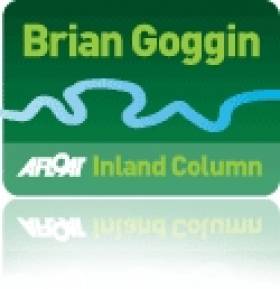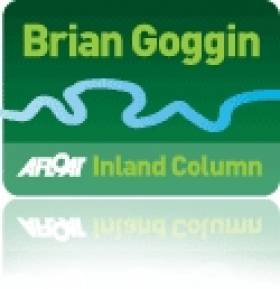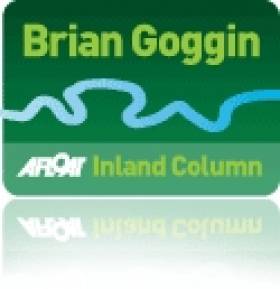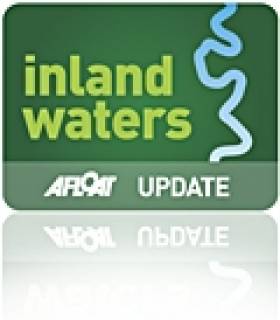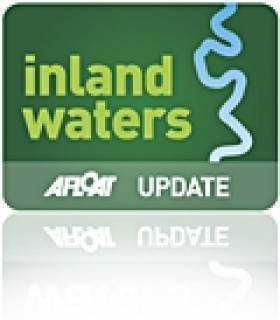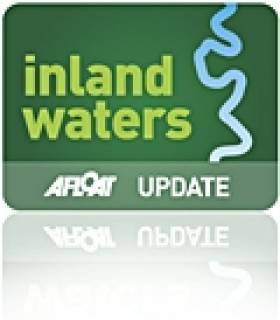Displaying items by tag: Royal Canal
Making Waves On The Canals
There's an old joke about a Scottish hellfire preacher trying to educate his flock about the punishment awaiting them if they do not mend their ways. He tells them that the ungodly will find themselves in the flames of hell, suffering unimaginable torments, and that they will cry to the lord for mercy, saying "Laird, laird, spare us: we didna ken whit torments awaited us." And, he tells them, the lord in his infinite goodness and mercy will gaze down upon them from heaven and he will say unto them "Well, ye ken noo".
WI and the canals
Some folk with boats on the Royal, Grand and Barrow may be feeling a bit like the ungodly at the moment, with the role of the lord being played by Waterways Ireland (WI). It seems that, as predicted here, WI is finally moving to take control of its canals.
Several new initiatives are under way, more are promised, some are predicted — and all in all it probably amounts to the biggest set of changes to boating on the canals since the end of commercial carrying. Furthermore, there are suggestions that the canals are being seen as a pilot study: that some of the changes will be applied to the Shannon and the Erne in years to come.
Cheap boating
Until now, you could keep a boat on the canals for e126 a year. That covered as many miles as you wanted and passage through as many locks as you wanted; it also covered mooring for the year. There is a bye-law that says you must not stay in one place for more than five days at a time, but it was widely ignored and scarcely ever enforced.
So you could, for example, keep your boat near Dublin, perhaps at a location close to a railway station, and live on it all year round. Or you could keep it there in the winter and move to the Shannon end for the summer, basing your boat at Shannon Harbour (Grand Canal), just one or two locks away from the Shannon, or at Richmond Harbour (Royal Canal), just one lock away. The cost was well below that of a Shannon marina berth.
The bye-laws simply did not reflect the ways in which people actually used boats, either as pleasure craft or for living on. And the charges to users were well below the cost of competitors' products (e.g. commercial marinas' charges), well below the charges on UK waterways and, in particular, well below the cost of running the waterways.
Costs to taxpayers
In the year ended 31 December 2010, WI's operating income, excluding "net deferred funding for pensions", was e547,000. That's the total for all waterways, coming from licences (e34,000), property (e210,000), operations (e202,000), interest (e1,000) and other (e100,000). The programme costs (excluding staff and other costs) were:
• Barrow e723,000
• Grand e2,074,000
• Royal e2,873,000
• the rest e2,098,000.
So the Grand, by itself, cost almost as much as the Lower Bann, the Erne, the Shannon and the Shannon–Erne Waterway put together. The Barrow, Grand and Royal accounted for 73% of the costs but for a far lower proportion of the boats and the income.
I don't intend that as a reflection on the efficiency with which the different waterways are operated: canals are entirely different in nature to river and lake navigations, with far more waterways infrastructure, and will cost more to run. But I give the figures for two reasons. First, they show that, if WI wanted to reduce the gap between income and expenditure, it would inevitably focus on the canals. Second, the figures give some idea of the extent of the subsidy being provided by the taxpayer to canal-based boaters: if there are, say, a thousand boats based on the canals and Barrow, each of them is being subsidised by (on average) about e5,500 a year from the taxpayer.
Costs to boaters
I'm always inclined to look at the economic angle, but WI doesn't dwell on it. Nonetheless it will increase the costs to boaters and will also increase WI's income. Instead of a single e126 annual charge, boaters will now pay
• e126 for a Combined Mooring
& Passage Permit
• e152 for an Extended Mooring
Permit (EMP)
• e250 as a damage deposit,
which I presume will be rolled
forward in succeeding years.
Furthermore, boaters applying for Extended Mooring Permits (EMPs) must produce insurance certificates; for anyone currently uninsured, that will be an extra cost, as will any survey and remedial work required.
There will be other extra costs, of which more below, in future years.
Controlling mooring
At the core of WI's current activity is its taking control of the banks. It is marking out lengths that can be allocated to boats; it will allocate those lengths to those applying for EMPs. It does not guarantee that boaters will get their preferred spaces, or that they will get the same space every year. But once a space has been allocated, it is reserved for one boat for the year and cannot be used by another. That probably seems obvious to anyone renting a marina berth but it will be a new practice on the canals.
The EMP system was applied first at Rathangan and Vicarstown on the Barrow Line, between Lock 34 and Griffith Bridge on the Grand and at Confey (Leixlip), 15th Lock and 45th Lock (near Richmond Harbour) on the Royal. The second batch will include places in the Grand Canal Dock in Dublin, at Pike Bridge, near Maynooth, and at Abbeyshrule on the Royal and near Lock 34 on the Royal. There will be more batches through to spring 2013; full details on http://www.waterwaysireland.org; select New Canal Permit System from the menu on the left.
Continuous Cruisers (as they're called in Britain), folk who stay no more than five days in one location, will not be required to have EMPs.
So what happens if a boater doesn't apply for an EMP but doesn't cruise continuously? If I'm reading the bye-laws correctly, WI has the power to remove a boat, store it and, if necessary, sell it, charging the owner for the costs of doing so.
Information or consultation?
There has been some criticism of WI for not holding consultation meetings before beginning to implement its new policy. My own view is that WI was right: such meetings produce more heat than light, with too much attention on minor individual matters and not enough useful comment on the principles. There is much to be said for creating facts on the ground.
But if consultation has been restricted, the flow of information has not. In fact WI has used its website very effectively, setting out its plans, explaining the procedures and providing FAQs with useful, not PR-type, answers. Whoever has been in charge of that exercise deserves to be commended.
Insurance and dry docking
One thing WI has communicated is that there is more to come.
From 2015 Waterways Ireland will be introducing the requirement for boats needing permits and wishing to use the canals to have a current hull survey to provide evidence that the boat is in good condition. [...] Your attention is being drawn to this requirement now to allow you time to prepare for 2015. [...]
The Licensee undertakes to have regular inspections of the gas and electric services of his Boat as required to ensure these are kept in a safe and serviceable condition. [...]
All Boats must carry adequate fire fighting equipment and have same serviced as per the manufacturer's recommendations. [...]
It is not permitted to re-fuel Boats at an extended mooring.
The requirement for insurance will probably mean more boats needing hull surveys; there is an explicit requirement for such surveys from 2015 onwards. That will put extra pressure on the dry docks, where WI has already introduced restrictions on the boats that can use them and the work that can be carried out. There is, in my view, an urgent and growing need for well-capitalised, well-managed boatyards along all our waterways. The requirements also suggest a need for more fuel sellers along the canals; as far as I know the only one is at Lowtown.
The Shannon and the Erne
The new arrangements will mean better management of the canals, safer boats and more income from WI, all desiderata. But the real excitement would come with their extension to the Shannon and the Erne. The legal basis for charging might have to be different, but WI must surely be planning to raise much more money from Shannon and Erne boaters. The current Shannon lock and bridge fees are pathetically small, hardly worth collecting, and they are not paid at all by those who stay on the lakes.
I am writing this before the Republic's budget is published, but I cannot imagine that it will contain good news for WI. I suspect that it will have to raise much more money itself, and that means from charges to various types of users. Robin Evans, chief executive of Canal & River Trust, which runs the former British Waterways navigations in England and Wales, said recently that his organisation gets only 35% of its funding from the State. The Irish Government must look enviously at that figure.
But it must consider the price elasticity of demand for inland boating. Usage, as measured (however imperfectly) by Shannon lock and bridge passages, has been falling over the last ten years. The chart below shows the figures for the first ten months of each year: at time of writing, figures for November and December 2012 were not available.
It may be time to reinvent the Shannon once again.
Down On Derg
For the last couple of years, we've done some long-distance boating; indeed in 2011 we didn't get to Lough Derg until the end of September. So we decided that, this year, we were not going anywhere north of Portumna: we would spend the year down on Derg.
Here are some of my impressions of the season. Some of them I may be able to check later, by looking for statistics or reports; some can't be checked because there are no statistics.
Weather
My first impression is that summer ended some time around May, with relatively little sunshine after that.
Even the nature of bad weather seems to have changed: the Royal Canal ran out of water in Spring but the Shannon had rather a lot of water throughout the summer. From time to time reports came from upstream of strong flows that made navigation difficult; down on Derg, Killaloe seemed to have strong currents quite a lot of the time, with water being pulled down the headrace to Ardnacrusha.
Met Éireann's report for the summer (June, July, August) seems to support that view: rainfall above average, sunshine and temperatures below average. It also seemed to me that we had more northerly winds than usual: the south-westerlies didn't seem to be the prevailing winds. However, the report says nothing about winds.
Numbers
My second impression is that lots of people have disappeared: that very few boats were moving on the lake this year: it was as if we were back to the early 1980s. I'll get the traffic figures from Waterways Ireland later: they cover only passages through locks and moving bridges, so they don't say anything directly about lake traffic, but they do give an idea of volumes.
Now, I may not be the best judge of numbers of boat movements because, if I hear there's a big boaty event on, I go somewhere else. But there seemed to be times when there was nothing moving on the middle of the lake, except sailing boats racing from Dromineer, Garrykennedy or Mountshannon. There weren't even many jetskis or speedboats around.
There were rumours of larger boats being sold to overseas buyers and transported out of the country, but I don't know how to check that. Even checking the total number of Shannon boat registrations wouldn't help: as there is no annual registration fee, there is no incentive for former owners to de-register boats that have been sold.
Dromineer
My third impression is that shore-based activity has diminished too.
As we keep our boat in the Shannon Sailing marina in Dromineer, we don't often use the public harbour, but we drive by it en route to the marina. It seemed to me to be pretty lifeless. Numbers of visiting boats seemed to be down (while numbers of resident boats rose), as did numbers visiting by land. (I don't know of any source of statistics for this; if there is one I'd like to know.)
I imagine that the poor weather kept land visitors away, except on the few sunny days. But I don't think that the improvements made a few years ago — path, pebbles, seats and so on — have done much to attract people. Dromineer needs to do more to establish itself as a place to visit, with things for people to do when they get there.
Harbour hoggers
My fourth impression is that harbour-hogging — leaving boats in public harbours for more than the permitted numbers of days, instead of paying for berths in private marinas — is on the increase. I don't know of any statistics on this, although I suspect that Waterways Ireland may have some. Its staff do patrol the harbours and record registration numbers, occasionally applying stickers to errant boats, so I imagine that they keep records of the numbers.
The problem is that WI has very little power, under the current bye-laws, to do anything effective. It needs a simple, cheap method of imposing ever-increasing charges on harbour-hoggers — and of enforcing payment. Experience with both the household charge and the mineral oil tax suggests that drastic steps may be required.
Other privatisers
The same may apply to other services that WI provides. Its very welcome supply of electricity can at least be controlled, with charges paid by card. However, I suspect that, when water charges are introduced, WI will have to devise a method of charging for water. Whether or not it wants to subsidise boaters, it is unlikely to want to supply folk who drive to its harbours to fill barrels and bottles with water (I have photographed folk doing just that).
And then there's the rubbish problem. Bins have been removed from some harbours on the west side of Lough Derg; a WI notice says that it has a "Leave No Trace" policy, or some such thing. That doesn't explain why there are still bins at harbours on the east side; I suspect that the explanation is in different arrangements with different local authorities. However, overseas tourists (if there are any) are likely to find it a little inconvenient to bring their holiday rubbish home with them, especially if they're flying by Ryanair.
But you can see WI's problem: if it makes free bins available, folk will drive from miles around to avoid paying charges. So, given that Irish folk are unlikely to develop civic-mindedness in the near future, the best solution is to use smart-card controlled bins, with each opening of the lid traceable to the individual boat-owner (or camper-van-owner). The same cards could control the other services and provide WI with a way of tracing user movements.
Supply and demand
The problem with free services is that they're too good to last: the provider, especially if it gets its money from an overstretched state, eventually realises it can't continue to provide them for nothing. So, just as declining income and other pressures reduce demand for its product, Waterways Ireland may find itself imposing extra charges that further reduce demand. It is not clear that any marketing campaign can compensate for the economic pressures on the sector.
Controlling The Canals
I wrote recently that the terms of Waterways Ireland's licence agreement for the "Extended Term Serviced Mooring Vacancies" at Shannon Harbour could be easily adapted for use elsewhere on the canals. That might allow WI to begin to bring the long-term berthers, residential or otherwise, under control. And so it proves. We have received this press release from Waterways Ireland.
WI Press Release
Waterways Ireland has recognised that many boat owners wish to stay for a more extended period in a single location than the 5 days the annual Canal Mooring and Passage Permit (under the Canals Act, 1986 (Bye-laws), 1988) currently allows.
In response, Waterways Ireland intends to issue an Extended Mooring Licence granting a boat owner the right to leave their boat in one location for longer than 5 days. This permit will enable the holder to moor in a position allocated by Waterways Ireland on a soft bank area of navigation property for a period of up to 1 year. The Extended Mooring Licence will cost e152 per annum.
The application process for the Extended Mooring Licence will open in the autumn when all existing permit holders will be contacted.
All boat owners will still require an annual Canal Mooring and Passage Permit allowing the holder to cruise and pass through locks. Boat owners with a Canal Mooring and Passage Permit proposing to stay longer in one location than 5 days can then apply for the Extended Mooring Licence. The total fee to hold both the Permit and the Licence in 2012/2013 will be e278.
For boat owners with the Canal Mooring and Passage Permit who do not hold an Extended Mooring Licence, the 5-day rule (in the one place or within 500m of that location) will still apply. Waterways Ireland will enforce this bye-law from autumn 2012.
Waterways Ireland will be contacting permit holders regularly between now and autumn 2012 to ensure they are kept up to date with the roll-out of the new permit. All queries about the enforcement of the current bye-laws or the Extended Mooring Licence should be directed to Shane Anderson, Assistant Inspector of Navigation: Tel no +353 (0)87 286 5726, Email [email protected].
These changes are necessary steps to improve the management of the canals and waterway amenities for both the navigational and recreational user, so that investment in the new infrastructure and facilities which Waterways Ireland has undertaken is maximised for every user.
Comment
About time too. I welcome this development: WI has to be able to control who uses its waterways and the uses they make of them.
The proposed charge is surprisingly modest. It is the same for all areas, those of high and of low demand: it might have been difficult to implement differential charging. However, the new licence does not apply to hard-edged areas; I presume therefore that WI intends to keep them clear for visitors.
It is significant that the new control mechanism is a licence, not a permit. Waterways Ireland had been hoping to bring in a single set of bye-laws to cover all its navigations, but it proved to be very difficult to do that within two jurisdictions. Accordingly, I understand that WI now intends to seek amendments to the bye-laws for the Republic, allowing it (inter alia) to increase the charges for various permits. However, the Canals Act 1986 allows WI to issue licences, and they are not subject to the restrictions in the bye-laws.
Royal water
The fragility of the water supply to the Royal Canal was shown in April, when Waterways Ireland closed the summit level of the canal because of low water levels; the 34th and 35th levels were also closed for emergency repairs. At time of writing, WI is hoping to be able to re-open the summit level on 1 June. Some boats that had intended to go west along the Royal to the Shannon were forced to go east instead, through Dublin and along the Grand Canal; happily, Effin Bridge, the lifting bridge at North Strand Road, worked properly this year.
The Royal always had fewer feeders than the Grand. The summit level was fed from Lough Owel, north of Mullingar, but while the canal was closed, Westmeath County Council found it needed more drinking water for the Mullingar area. In dry conditions, the Lough Owel feeder cannot meet both needs.
With great foresight, CIE (which then owned the canal) got the Council to agree that, if the canal was to be re-opened, it would provide an alternative supply.
Nowadays, environmental regulations mean that water abstraction needs more thought, more planning and more factors to be considered. Extensive studies were carried out and WI and the County Council agreed that the best possible alternative source was Lough Ennell, which is south of Mullingar: water could be pumped from there to the canal. The Council had to apply to An Bord Pleanála for permission; it has just completed oral hearings in Mullingar.
Traditional boats
In the first half of the nineteenth century, anyone travelling to the seaside resort of Kilkee could take the steamer to Kilrush and travel onward by road. But the passenger traffic was initially established by the turf boats of the Shannon Estuary: most of Limerick's fuel came from Poulnasherry, west of Kilrush, and was carried by small sailing boats, which also carried a few passengers.
A 24' replica of one of these boats was launched recently at Querrin, at the entrance to Poulnasherry. The Sally O'Keeffe was built by the Seol Sionna group http://seolsionna.org/, which grew out of the West Clare Currach Club. The boat will be used for sailing training. The Shannon Estuary, which is insufficiently appreciated, has a wealth of traditional boat types, but there were no extant Shannon hookers, so it is nice to see their return.
On the same weekend, another of those traditional boat types was featured in Limerick. The Ilen Wooden Boat Building School http://ilen.ie/gandelow-races/ had built five gandelows, boats used in the upper reaches of the estuary, and conducted races in the city.
And the Thomastown Regatta, on the Nore http://www.happyvalleyfestival.com/ebooklet.pdf, will feature traditional cots and racing boats: the 1905 racing cot Nore Lass, owned by the O'Farrell family, will be on display at the Grennan Mill Craft School.
Here are some updates I wrote about recently...
Water charges
The EU Commission sent a Reasoned Opinion to Ireland in November 2011, suggesting that Ireland had not correctly implemented the provisions of the Water Framework Directive that require "a cost recovery policy for water services that includes the environmental and resource costs of water use". The Commission believes that cost recovery should be extended to many other water uses, including hydroelectricity generation and the supply of water to navigations. Having got an extension of the deadline for replying, the Department of the Environment, Community and Local Government responded to the Commission. I asked for a copy of the response, but the department won't tell anybody what it's doing. I am appealing that decision, but without much hope.
Traffic
Waterways Ireland has kindly given me the Shannon traffic figures for the first four months of 2012. The numbers of movements in those months are always low, and can be significantly affected by the weather, so there can be quite a lot of variation between one year and another without its indicating any long-term trend. For example, back in 2002, there were 4875 boat movements in the first four months; the figure was up to 6204 in 2003 but back down to 5304 in 2004. It's important therefore not to read too much into the figures, but a five-year moving average suggests that traffic has been falling since 2007. The figure for 2012 was 4052. It will be interesting to see whether better weather balances economic gloom in the rest of the year.
Mineral Oil Tax
In the last issue, I gave the figures for the numbers of Mineral Oil Tax returns received by Revenue from owners of diesel-powered boats in the first two years of the scheme's operation. They told me that they got 38 returns in 2010 for the year 2009 and 41 in 2011 for 2010. I now have the figure for the following year, the returns made in 2012 for the year 2011. There was a very significant change, of 46%, but unfortunately it was downward, to 22. The Revenue Commissioners tell me that "[...] there were 22 returns received by 1 March 2012 for 2011, amounting to e53,398.58 MOT [Mineral Oil Tax] on 141,503.29 litres oil." That's an average of 6432.1 litres each, which is a lot, so I suspect that much of the total came from the hire fleet, with less than twenty private owners making returns.
Royal and Ulster Canals
I said, in the last issue, that I did not understand how the cost of the restoration of the Royal Canal, 146 km with 46 locks, could be less than the expected cost of the canal to Clones, 13 km with one double lock. It has been explained to me that the figure for the Royal was essentially only the marginal cost, recorded (initially) under Civil Service accounting procedures, so that it understates the total cost. It would be a huge job to try to find the full cost using modern accounting conventions, but unfortunately that means that we have no usable figure for the cost of the Royal, no basis for estimating the return on investment and no guideline on the value of any future restorations.
Grand, Royal Canal & Barrow Navigation Mooring Rules Come into Force
#inland – Waterways Ireland announced in June 2012 that the Canal Bye-laws on the Grand & Royal Canal and Barrow Navigation are to be enforced from autumn 2012, with an accompanying change in the permit system allowing for year-long mooring permits and locations.
Part of bringing in this new location-based permit has been the identification of locations suitable for extended mooring. This process is now completed and work has begun in some areas to improve accessibility.
Waterways Ireland will roll out Extended Mooring Permit applications by area, rather than giving a date when applications for the permit will open. For boat owners this will mean that enforcement of the maximum stay rule will not commence in an area until after boat owners have had the opportunity to purchase an Extended Mooring Permit.
The initial 12 month Extended Mooring Permit will cost €152 and will only be available to boats already holding a valid annual Mooring and Passage Permit.
Boats that cruise and move (staying at a mooring for up to 5 days) will not be in breach of the Bye-laws or require an Extended Mooring Permit.
Waterways Ireland has proposed a small number of draft amendments to the current Bye-laws which date from 1988. These include proposals to provide a range of charges for mooring permits that reflect the location and services provided throughout the canals and also will take into account the size of boat. These proposals include low cost rural moorings on soft banks to ensure the canals are accessible for everyone who owns a boat and requires a mooring. Boat owners allocated an extended mooring location in key areas in villages or towns or with services should be aware that if the new Bye-laws are approved Waterways Ireland will increase the charges for moorings in the future to reflect the location, services, and size of boat.
Waterways Ireland recognises the current situation whereby a small number of boat owners use their boats as their sole or permanent residence. Proposals to make provision for this use of the navigation property have been included in the Bye-law changes.
Furthermore Waterways Ireland intends to work towards the provision of a small number of serviced house boat moorings on the canal network. Such provision will be subject to finance, land availability and compliance with requisite statutory approvals.
Waterways Ireland recognises that a transition period of a number of years will be required to implement this. In the interim these boat owners should apply for an Extended Mooring Permit.
The draft Bye Law amendments are currently being considered by Waterways Ireland's sponsor Departments. When Waterways Ireland has Ministerial consent, it will proceed to public consultation on the proposed Bye-law amendments.
Waterways Ireland will continue to contact permit holders regularly to ensure they are kept up to date with the roll-out of the new permit. All queries about the enforcement of the current bye-laws or the Extended Mooring Permit should be directed to Shane Anderson, Assistant Inspector of Navigation: Tel no +353 (0)87 286 5726, Email [email protected] . Queries about houseboats should be directed to Property & Legal Section Tel no +44 (0)28 6632 3004.
These changes are necessary steps to improve the management of the canals and waterway amenities for both the navigational and recreational user, so that investment in the new infrastructure and facilities which Waterways Ireland has undertaken is maximised for every user.
Minister Proposes Dublin-to-Galway Cycle Path Via Royal Canal
#ROYAL CANAL - The Royal Canal towpath is an "obvious candidate" for a stretch of the new cross-country cycle route from Dublin to Galway proposed by the Minister or Transport.
The Irish Times reports that Minister Leo Varadkar has instructed the National Transport Authority (NTA) to examine possible routes for the project, which would involve development of the present towpath along the waterway from Mullingar to Maynooth.
The NTA is already funding preparatory work with a view to upgrading the canal path as a premium quality Greenway Route for cyclists and pedestrians in the Fingal area from Ashtown to Westmanstown - and will now look at the feasibility of extending this project through Leixlip to Maynooth.
“A national off-road cycle trail would be a first for Ireland and would be a great tourism asset," said the minister, who added that the scheme has "the potential to bring in at least €15 million per annum, much of that going straight into local businesses along the route.”
Waterways Notice: Royal Canal Closure in Meath, Lower Bann Lock Restrictions
#INLAND WATERWAYS - Waterways Ireland has issued notice of a planned closure of the Royal Canal in Clonard, Co Meath over the winter months, as well as restrictions on the Lower Bann this coming Wednesday.
In Clonard, the stretch of the canal between Blackshade Bridge and Hill of Down will be closed from 1 October 2012 till 17 March 2013 to facilitate essential bank strengthening works.
Waterways Ireland wishes to thank all owners and masters of vessels using the Royal Canal for their co-operation in this matter.
Meanwhile, on the Lower Bann there will be an interruption to electricity supply in the Movanagher area in Co Derry this Wednesday 19 September.
All owners and masters are advised that there will be restricted access to Movanagher Lock and swing bridge on that date, and vessels of more than 26 feet (8 metres) will not be permitted to make passage.
Strange Goings On As Turtle, Carp Appear in Royal Canal
#INLAND WATERWAYS - The Irish Times recently reported on some strange and unusual findings along one of Ireland's longest inland waterways this summer.
Angler Tony Masterson was more than a little surprised to discover he had caught a red-eared slider turtle in the Mullingar section of the Royal Canal last month.
The 30cm turtle is of a species native to the southern United States, so is presumably an abandoned pet - a cause of concern as the number of invasive species in Ireland continues to expand.
Inland Fisheries Ireland (IFI) senior scientist Joe Caffrey reminded the public that it is "illegal to release any species that is not normally resident in Ireland into the wild" and added that the IFI "will continue to monitor the canal to ensure this is a once-off case".
Curiously, a wild salmon was caught the same stretch of canal last year.
It's thought that the salmon entered the canal via the water supply system from Lough Owel, which is connected to the Shannon by the River Inny.
IFI officers have also confirmed the sighting of a koi carp in the Royal Canal, which "appears to be in good condition".
Public Consultation on Royal Canal Greenway Study
#INLAND WATERWAYS - Fingal County Council invites any interested parties to make submissions on the future of the Royal Canal as a Greenway Route in the Fingal area.
The council, in conjunction with the National Transport Authority and Waterways Ireland, has identified the potential to upgrade the canal towpath along the Royal Canal from Ashtown to Westmanstown to a premium quality cycle and pedestrian route.
The feasibility of the Royal Canal for such facilities and as an improved recreational amenity is currently being examined. Among the issues being considered are:
- Feasibility of providing a high quality continuous footpath/cycleway along the towpath
- Potential to provide parallel routes where towpath route not feasible
- Improvements to accessibility issues at interfaces with public roads
- Improved amenity areas (car parking, picnic areas, angling, boating)
- Environmental and heritage issues
- Improved connectivity with local residential areas and adjacent rail and bus services
- Integration with adjacent cycle routes (existing and proposed)
Submissions or observations may be made in writing to Senior Executive Officer, Planning & Strategic Infrastructure Department, Fingal County Council, Main Street, Swords, Co Dublin to arrive no later than 5pm on 25 May 2012 or e-mail to [email protected].
Father-Son Duo in Charity Paddle from Dublin to Donegal
#KAYAKING - A father-and-son duo from north Co Dublin will shortly embark on an epic kayak paddle from Dublin to Donegal, the Fingal Independent reports.
Dermot Higgins and his son Fionn, from Rush, will attempt to kayak from Dublin Port to the Atlantic Ocean at Ballyshannon - a distance of some 330km - by way of the Royal Canal, the River Shannon and Lough Erne.
The Higgins' - who believe they are the first to attempt such a feat - will be completely self-sufficuent for the duration of the challenge, which is hoped to raised funds for the Rush Open Organisation for Transition Status (ROOTS), a charity that intends to help communities reduce their carbon footprint and face up to environmental challenges by encouraging sustainability.
The Fingal Independent has more on the story HERE.
Royal Canal Site In Phibsborough On the Market
#WATERFRONT PROPERTY - A prime development opportunity on the banks of the Royal Canal in Phibsborough is now available.
With an asking price of €1.5 million, the site of the Old Mill Bakery is situated just 1.5km from Dublin city centre and is adjacent to the amenities of Phibsborough Shopping Centre, with 150 metres of frontage on the Royal Canal.
Zoned Z1 for residential, the 1.6 acre site has great potential for residential or mixed use development. A feasibility study is available for any housing schemes.
Viewing is strictly by appointment only. For more details visit the website of estate agent CB Richard Ellis HERE.


























